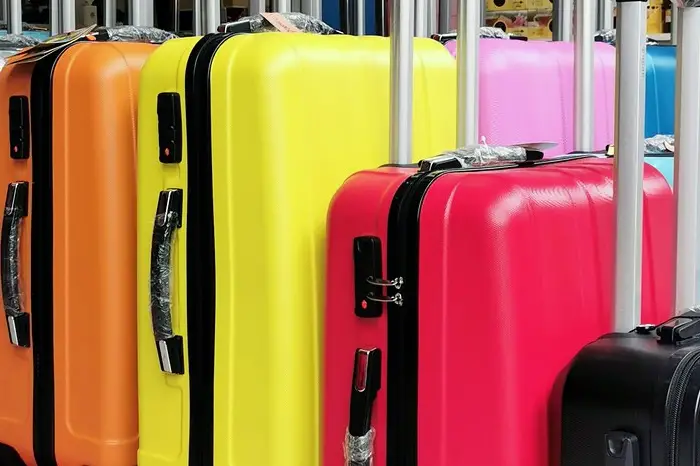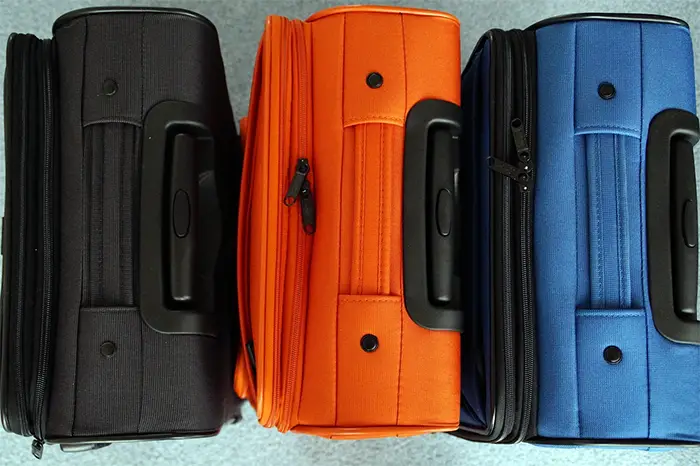That new luggage is beautiful, and you take every precaution to keep it looking that way. No matter how much care you take, those bags will get soiled as they pass through terminals, hotels, and delivery vehicles.
No doubt you have stood by the luggage carousel and watched as the various pieces passed. The bags mostly looked worn-out and dirty, exposed to weather conditions, baggage handlers, and travel wear and tear.
There is good news for you – and your luggage! Here are some helpful, easy tips to protect and clean your bags and keep them looking good inside and out.
How to Clean the Inside of a Suitcase
We’ve all experienced the leaking bottle of something inside our carefully packed luggage. Although you used every precaution, that one element spilled and left a mess or stain.
- Remove all attachable pockets and items. Handwash those in the sink with water and a few drops of gentle soap. Rinse. Some may be safe to put in the washer on a gentle cycle and then hang to air-dry.
- Unzip all interior parts, turn the bag over and shake out the dust and small debris. Use the small nozzle attachment on your vacuum to get any residue.
- With a damp cloth using no soap, wipe the entire lining of the suitcase.
- After wiping with the damp cloth, you may still see a stain. Mix water and a gentle soap drop, then use a small brush (an old toothbrush works well), clean just that area.
- Gently wipe with a damp cloth to rinse until all soap residue is gone. Allow to air-dry.
- Replace all attachable pockets and items.
- Apply sanitizing spray (like Lysol) lightly to kill germs and viruses.
There are two basic styles of exteriors available on luggage. Personal preference in style and budget will determine most selections. The first section deals with cleaning hard side luggage.
Hardside Luggage Cleaning Tips
These tips will work on most molded plastic, soft vinyl, polycarbonate, ABS, polypropylene, and aluminum exteriors. Always refer to the manufacturer’s recommendations and guidelines.
- Most luggage manufacturers recommend only using warm water with gentle dish soap and a soft cloth, as other cleaners may remove the protective coating applied by the manufacturer.
- After washing the bag’s exterior, use clean water to rinse all soap residue.
- Dry with a clean cloth.
- Removing Scratches:
- Cleaning with water and gentle soap will make scratches visible.
- Use a pencil eraser to rub across the scratch a few times. More minor scratches will disappear.
- Apply regular toothpaste and brush with an old toothbrush to make the blemish of deeper scratches less visible.
- You may choose to wax your hard-side luggage to freshen the luster, as well as add future resistance. Use only a silicone-based automotive or furniture polish. Never use a combo cleaner-polish, which can damage the original protective coating. Buff to recover the high-gloss sheen when the case was new.

Aluminum Luggage Cleaning Tips
Although tough and durable, aluminum cases will encounter abuse in handling and show dings, dents, scuffs, and scratches more easily than darker or colored hard side luggage. Although you may be tempted to use cleaning products for other aluminum materials, it is essential to follow the guidelines below.
- Never use cleaning products that contain abrasives, ammonia, acetone, chloroform, benzene, and phenol-based compounds, and these materials can damage the shiny, polished aluminum surface.
- Apply warm water and a gentle soap mixture with a washcloth or a soft sponge.
- Be sure to wipe the entire shell, or there will be dark patches.
- Rinse the surface with a damp sponge, then dry with a soft cloth.
- Remove scuff marks from aluminum:
- Use a soft cloth and dip it in light alcohol or spot remover. Then, gently rub it on the scuff mark.
- Only use it on the scuff mark.
- Using a luggage cover can help prevent dings, dents, and scratches to aluminum-sided luggage.
Soft-sided Luggage Cleaning Tips
Softside is among the most popular and affordable styles of luggage. It includes polyester, nylon, cotton, leather, vinyl, and other lightweight, durable, and flexible fabrics.
- Like the hard side luggage, use warm water with mild dish soap, and apply to the exterior with a brush in circular motions.
- If this does not remove the spot(s), try using a spot removal product (i.e., Spray ‘n Wash or similar)
- If the spot(s) is still visible, use a foam-type cleaner for furniture or car upholstery. Spray on and work in with a brush. Allow it to dry, then wipe with a damp cloth or sponge. Once dry, vacuum the surface to remove any residue.
- Cleaning Grease Spots:
Grease spots come from luggage traveling on conveyor belts, sitting on tarmacs or concrete, trains, planes, or bus compartments. Do not rub grease spots as it can cause them to absorb deeper into the material. Complete removal may not be possible if your fabric is brightly colored, but this process can diminish the mark’s visibility.
- Pour dry baking soda and cornstarch on the spot. Work it in with an old toothbrush and allow 10-15 minutes to absorb.
- Brush off the baking soda/cornstarch.
- Using a glass, fill halfway with a solution of warm water, 1 Tbsp of dish soap, and 1 Tbsp of an oxi powder. Mix.
- Apply to the grease spot with a toothbrush, working it in for 1-2 minutes.
- Rinse with a cloth and warm water.
- Allow to air-dry.

Leather Luggage Cleaning Tips
- Use a dry cloth to remove all dust and dirt.
- Use a dry brush around corners and seams.
- Apply a leather cleaner using a soft cloth. (Note: suede requires a suede leather cleaner).
- For scratches, use a leather marker or shoe polish to fill in. Make sure to purchase the right color.
- For more significant scratches, pour a teaspoon of olive oil on a smooth cloth. Gently rub in and allow to sit for 5 minutes.
- Using a soft cloth, buff the area.
- Apply leather conditioner to remove minor and slight scuff marks and restore the original color to the bag.
Dry-Cleaning Softside Luggage
If cleaning your luggage is not something you care to do, some dry-cleaning services will process your case for $30-$70. Be sure to call and ask before taking your bag.
Additional Tips for Care
No matter what your luggage style preference may be, keeping it well maintained should give you years of good use. Here are some added tips for cleaning and maintaining your luggage.
Wheels
- Keep the wheels rolling smoothly by cleaning around them with a toothbrush to remove any debris.
- Use a silicone-based spray or dry bicycle oil to lubricate the wheels. Use sparingly to avoid getting any on the luggage’s fabric.
Plastic Parts
- Use soapy water and a cloth to remove dust and debris.
- Apply regular olive oil to a soft cloth to restore the original deep color. It will also reduce the appearance of minor scratches, or,
- You can purchase a black plastic trim restorer at most auto stores if the parts are black. Carefully rub on the plastic part(s), avoiding contact with the other parts of the suitcase.
Remember, having a reliable bag that meets your travel needs is like having a good friend on every trip.
Are Luggage Covers Worth it?
If your luggage is new or still in good condition, you may want to consider investing in a luggage cover.
Also known as suitcase covers, these can be removed and periodically tossed in the washing machine. The covers help protect your luggage from becoming battered or marred too soon. They come in various colors and patterns, making them easy to identify.
TSA allows luggage covers as long as the cover is easy to open if your bag is chosen to be searched. If TSA cannot access your luggage, they may cut the cover off.
An additional benefit of a luggage cover is protecting and maintaining the contents when the bag pops open during transit.
